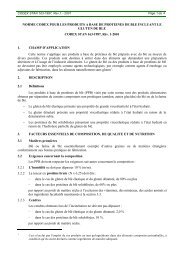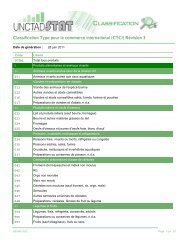issues and constraints related to the development of cashew nuts ...
issues and constraints related to the development of cashew nuts ...
issues and constraints related to the development of cashew nuts ...
You also want an ePaper? Increase the reach of your titles
YUMPU automatically turns print PDFs into web optimized ePapers that Google loves.
1ITCINTERNATIONAL TRADE CENTRECOMMON FUND FOR COMMODITIESREUNION REGIONALE SUR LE DEVELOPPEMENT DESEXPORTATIONS DE NOIX DE CAJOU D’AFRIQUEOrganisée par le Centre de Commerce International/CNUCED/OMC (CCI) etle Fond Commun de Produits de Base (CFC),en collaboration avec le Conseil National pourl ’Exportation (CNEX)23-26 juillet 2002, HÔTEL DU PORT – « LA MARINA », Co<strong>to</strong>nou, BéninISSUES AND CONSTRAINTS RELATED TO THEDEVELOPMENT OF CASHEW NUTS FROM FIVESELECTED AFRICAN COUNTRIES(CÔTE D’IVOIRE, GHANA, GUINEA,GUINEA BISSAU AND NIGERIA)Presentation made byDr. Clive P TopperProject No. INT/W3/69“Développement des exportations des noix de cajou d’Afrique”
2CONTENTSPage1. Introduction 32. Production <strong>constraints</strong> 32.1 Biotic <strong>constraints</strong> 32.2 Environmental <strong>constraints</strong> 102.3 Constraints <strong>related</strong> <strong>to</strong> breeding,planting material <strong>and</strong> research 122.4 L<strong>and</strong> <strong>and</strong> climatic <strong>constraints</strong> 172.5 Extension <strong>and</strong> farmers’ organisation 183. Marketing <strong>constraints</strong> 204. Processing status <strong>and</strong> <strong>constraints</strong> 215. Recommendations 23References 24
31. IntroductionThe purpose <strong>of</strong> this paper is <strong>to</strong> give an overview <strong>of</strong> <strong>constraints</strong> <strong>and</strong> opportunities for <strong>cashew</strong>export <strong>development</strong> in five West African countries, namely Côte d’Ivoire, Ghana, Guinea Bissau,Guinea <strong>and</strong> Nigeria.This paper is based on two surveys1 conducted in 1999 <strong>and</strong> in 2001, <strong>and</strong> funded by funded by <strong>the</strong>USAID, in <strong>the</strong> framework <strong>of</strong> <strong>the</strong> Sustainable Tree Crops Program (STCP). The aim <strong>of</strong> <strong>the</strong>Sustainable Tree Crops Program is “<strong>to</strong> improve <strong>the</strong> well-being <strong>of</strong> smallholder farmers, through<strong>the</strong> <strong>development</strong> <strong>of</strong> sustainable tree crop systems that increase productivity, generate income,conserve biodiversity, use natural resources in a sustainable manner <strong>and</strong> <strong>of</strong>fer stable <strong>development</strong>prospects <strong>and</strong> long-term economic incentives”. The program focuses on 3 tree crops, namely<strong>cashew</strong>, cocoa <strong>and</strong> c<strong>of</strong>fee.Data for individual countries are only presented in <strong>the</strong> form <strong>of</strong> general conclusions, or with aview <strong>to</strong> illustrate a specific points, as much <strong>of</strong> <strong>the</strong> findings <strong>of</strong> <strong>the</strong> two studies are on <strong>the</strong> wholesimilar.The two surveys were based on:- The analysis <strong>of</strong> detailed questionnaires completed by various research institutes;- Field visits made by <strong>the</strong> teams, during which thous<strong>and</strong>s <strong>of</strong> trees were inspected <strong>and</strong>observed at <strong>the</strong> time <strong>of</strong> panicle production, flowering <strong>and</strong> nut set in differentregions in <strong>the</strong> five countries surveyed. This time period was <strong>the</strong> most critical withregard <strong>to</strong> production <strong>of</strong> <strong>nuts</strong> <strong>and</strong> apples. It was also <strong>the</strong> time when pests <strong>and</strong>diseases were at <strong>the</strong>ir most damaging. Naturally <strong>the</strong>re may have been o<strong>the</strong>r pests<strong>and</strong> diseases that occurred at o<strong>the</strong>r times <strong>of</strong> <strong>the</strong> year, but <strong>the</strong>ir effect would havebeen mainly on vegetative production. Fortunately <strong>cashew</strong> trees can withst<strong>and</strong>substantial damage <strong>to</strong> leaves, before <strong>the</strong>re is a reduction in yield. It is also almostcertain that pest populations will vary in intensity from year <strong>to</strong> year <strong>and</strong> place <strong>to</strong>place;- Discussions with farmers, extension workers, processors, traders, etc.2. Production <strong>constraints</strong>2.1 Biotic <strong>constraints</strong> Insect pestsDamage from <strong>the</strong> different insect species, albeit at different levels <strong>of</strong> seriousness, was generallywidespread throughout all <strong>the</strong> countries surveyed. Even though, perhaps, a particular insect pestspecies was not a problem in one country at <strong>the</strong> time <strong>of</strong> <strong>the</strong> survey, many insect pests have <strong>the</strong>1 “Assessment <strong>of</strong> Options <strong>and</strong> Opportunities for Tree Crop Development in East <strong>and</strong>West/Central Africa” by Dr. Clive P. Topper <strong>and</strong> Pr<strong>of</strong>essor Peter Caligari, 1999, <strong>and</strong>“West Africa Regional Cashew Survey (covering <strong>the</strong> countries Guinea, Guinea Bissau,Cote d’Ivoire, Ghana <strong>and</strong> Nigeria), Volume 1”, by Dr. Clive P. Topper, Pr<strong>of</strong>. PeterCaligari, Dr. Mahmoud Camara, Mr. Souret Diaora, Mr. Akadie Djaha, Dr. FelixCoulibaly, Dr. A. K. Asante, Dr. Adomako Boamah, Mr. E. Akin Ayodele, Mr. Patrick O.Adebola, 2001.
4ability <strong>to</strong> move long distances, <strong>and</strong> could well become a pest in a new place in <strong>the</strong> future. Inaddition, as <strong>the</strong> area <strong>of</strong> <strong>cashew</strong> exp<strong>and</strong>s <strong>and</strong> increases, pest dynamics also change, <strong>of</strong>ten for <strong>the</strong>worse.Sucking pestsHelopeltis sp (Hemiptera: sub-order Heteroptera: family Miridae)Helopeltis was present at many <strong>of</strong> <strong>the</strong> sites visited throughout Guinea, Guinea Bissau <strong>and</strong> Coted’Ivoire. Helopeltis was also present in Ghana, but <strong>the</strong>re Anoplocnemis curvipes damage wasano<strong>the</strong>r common feature at some sites (see next section) <strong>and</strong> it was difficult <strong>to</strong> distinguish <strong>the</strong>relative importance <strong>of</strong> Helopeltis. In Nigeria Helopeltis was present but damage levels were verylow.Helopeltis was responsible for significant loss <strong>of</strong> yield at a number <strong>of</strong> sites, most notably inGuinea.Helopeltis sucking pest leaf damage can take <strong>the</strong> form <strong>of</strong> black lesions on petioles or on <strong>the</strong> leafmidrib, or black angular spots on <strong>the</strong> leaf surface. Typical feeding damage on stems appears as adiscoloured, necrotic area or lesion; similar lesions also occur on fruits <strong>and</strong> developing <strong>nuts</strong>. (Peopleencountered during <strong>the</strong> course <strong>of</strong> <strong>the</strong> surveys were <strong>of</strong>ten identifying this type <strong>of</strong> damage as beingcaused by anthracnose.) When Helopeltis feeding pressure is sufficiently intense, <strong>the</strong> whole shoot dies<strong>and</strong> this damage is typically called ‘Dieback’ (see Pho<strong>to</strong>graph 1). In very serious cases, <strong>the</strong> entire treelooks burnt.In East Africa, <strong>the</strong> sucking pests Helopeltis anacardii, H. schoutedenii <strong>and</strong> Pseudo<strong>the</strong>raptus wayiBrown (Hemiptera: Coreidae) are <strong>the</strong> main insect pests <strong>of</strong> <strong>cashew</strong> <strong>and</strong> studies <strong>the</strong>re have shownthat sucking pest damage can be very variable from year <strong>to</strong> year <strong>and</strong> place <strong>to</strong> place (Boma et al.1998 <strong>and</strong> Topper et al, 1998). It is <strong>the</strong>refore, highly likely that Helopeltis damage in West Africacould vary in intensity from year <strong>to</strong> year <strong>and</strong> place <strong>to</strong> place, depending upon environmentalfac<strong>to</strong>rs, age <strong>and</strong> attractiveness <strong>of</strong> <strong>cashew</strong> <strong>and</strong> o<strong>the</strong>r host plants in <strong>the</strong> vicinity. In India, Helopeltisan<strong>to</strong>nii (<strong>the</strong> tea mosqui<strong>to</strong>) is <strong>the</strong> main production constraint.Anoplocnemis curvipes (Hemiptera; sub-order Heteroptera; family Coreidae)Damage symp<strong>to</strong>msA. curvipes are in <strong>the</strong> same sub-order <strong>of</strong> insects as Helopeltis <strong>and</strong> <strong>the</strong>y feed in a similar way, bypenetrating <strong>the</strong> living t<strong>issues</strong> <strong>of</strong> plants with <strong>the</strong>ir piercing mouthparts <strong>and</strong> imbibing <strong>the</strong> sap. (seePho<strong>to</strong>graph 2).A. curvipes damage (see Pho<strong>to</strong>graphs 3 <strong>and</strong> 4) was found <strong>to</strong> be widespread in West Africa <strong>and</strong>was particularly serious in Cote d’Ivoire <strong>and</strong> Ghana, where farmers <strong>of</strong>ten wanted <strong>to</strong> spray in order<strong>to</strong> protect <strong>the</strong>ir <strong>cashew</strong> trees, but resources were not available.According <strong>to</strong> Hill <strong>and</strong> Waller (1988), A. curvipes is distributed throughout Africa, where <strong>the</strong>ysuck <strong>the</strong> sap <strong>of</strong> a variety <strong>of</strong> plants including both sesame <strong>and</strong> c<strong>of</strong>fee.Thrips (Thysanoptera: Thripidae).Many species <strong>of</strong> thrips exist <strong>and</strong> it is likely that more than one species could attack <strong>cashew</strong> inWest Africa. The Plant Protection department in Guinea Bissau had identified Selenothrips sp. asone c<strong>and</strong>idate.
5The severity <strong>of</strong> attack by thrips usually varies from year <strong>to</strong> year <strong>and</strong> place <strong>to</strong> place <strong>and</strong> normally<strong>the</strong>y are only dry season pests; as soon as <strong>the</strong> heavy rains start <strong>the</strong>y disappear.Damage symp<strong>to</strong>msThe vast majority <strong>of</strong> thrips species derive <strong>the</strong>ir nutriment by penetrating <strong>the</strong> living t<strong>issues</strong> <strong>of</strong>plants with <strong>the</strong>ir piercing mouthparts <strong>and</strong> imbibing <strong>the</strong> sap. Loss <strong>of</strong> sap can result in yield loss<strong>and</strong> some thrips species can transmit viral diseases. As a result <strong>of</strong> such feeding, mainly on <strong>the</strong>more mature <strong>cashew</strong> leaves, <strong>the</strong>y turn a bronze colour <strong>and</strong> eventually drop <strong>of</strong>f.Thrips were widespread throughout <strong>the</strong> 5 countries surveyed; usually damage was minor <strong>and</strong> <strong>of</strong>no economic significance. However at a few places in Guinea <strong>and</strong> Ghana in particular, thripswere responsible for serious levels <strong>of</strong> defoliation <strong>and</strong> yield loss.At <strong>the</strong> MIM Estate in Ghana, thrips <strong>and</strong> o<strong>the</strong>r sucking pests were a major problem. They have <strong>to</strong>spray 3 or 4 times every year <strong>to</strong> control <strong>the</strong> thrips; without this, <strong>the</strong> trees would be completelydefoliated. Trac<strong>to</strong>r-drawn sprayers were used, since backpack mo<strong>to</strong>rised blowers could not do<strong>the</strong> job. Interestingly, <strong>the</strong> trees from Indian seed were apparently more susceptible <strong>to</strong> damagefrom thrips than <strong>the</strong> local trees.Trunk borers <strong>and</strong> girdlersEvidence <strong>of</strong> trunk boring insects was seen at various places throughout <strong>the</strong> survey but <strong>the</strong> number<strong>of</strong> trees affected was small.Apate terebrans (Coleoptera, family Bostrychidae)The most spectacular example <strong>of</strong> borer damage was found in Seguela district, Cote d’Ivoire. Inone 6 year old tree, 37 adult borers were found causing extreme damage <strong>and</strong> <strong>the</strong> death <strong>of</strong> <strong>the</strong> tree.The following information was provided by <strong>the</strong> Natural His<strong>to</strong>ry Museum (UK): “This species iswidespread throughout Africa <strong>and</strong> Madagascar <strong>and</strong> has been introduced in<strong>to</strong> Central <strong>and</strong> SouthAmerica. The larvae develop in a variety <strong>of</strong> timbers, including living trees <strong>and</strong> constructionwood. The adults also feed in <strong>the</strong> wood <strong>and</strong> <strong>the</strong>y can damage young trees, causing death. Thelife cycle is usually 1 <strong>to</strong> 3 years depending on <strong>the</strong> condition <strong>of</strong> <strong>the</strong> wood, moisture content, exten<strong>to</strong>f infestation, etc. Adult beetles will disperse naturally by flight but <strong>the</strong>y have also been spreadfur<strong>the</strong>r by trade”.A. terebrans is polyphagus <strong>and</strong> Hill <strong>and</strong> Waller (1988) record A. terebrans as attacking c<strong>of</strong>fee,citrus, cocoa, guava, cot<strong>to</strong>n <strong>and</strong> o<strong>the</strong>r plants.Cultural control is usually recommended, whereby a flexible wire (e.g. a bicycle spoke), ispushed in<strong>to</strong> <strong>the</strong> tunnels <strong>to</strong> kill <strong>the</strong> larvae or adults. Insecticide-soaked cot<strong>to</strong>n wool can also bepushed in<strong>to</strong> <strong>the</strong> holes <strong>to</strong> kill <strong>the</strong> insect. Borer damage is usually restricted <strong>to</strong> a small number <strong>of</strong>trees, <strong>and</strong> with vigilance <strong>and</strong> <strong>the</strong> appropriate cultural control knowledge, it can be kept undercontrol quite easily.Analeptes trifasciata (Coleoptera, Cerambycidae)Damage by this pest was mainly seen in Nigeria, but it has been reported as being a problem inall <strong>the</strong> countries surveyed.
6Damage symp<strong>to</strong>ms:Damage <strong>to</strong> trees is quite characteristic, branches are completely girdled, with a V-section cut by<strong>the</strong> adult beetles. Only a small segment <strong>of</strong> <strong>the</strong> branch remains, which is <strong>to</strong>o weak <strong>to</strong> hold <strong>the</strong> fullweight <strong>and</strong> hence <strong>the</strong> branch eventually breaks <strong>of</strong>f. The purpose <strong>of</strong> <strong>the</strong> girdling is <strong>to</strong> providesuitable breeding material for <strong>the</strong> larvae, in <strong>the</strong> form <strong>of</strong> dead wood. Eggs are laid on <strong>the</strong> cutbranch <strong>and</strong>, on hatching , <strong>the</strong> larvae burrow in<strong>to</strong> <strong>the</strong> wood. The adult is a typical “longicorn”beetle with attractive colour; it can reach a length <strong>of</strong> about 55mm <strong>and</strong> its antennae a fur<strong>the</strong>r70mm. The adult is generally black, with 3 bright orange coloured b<strong>and</strong>s on <strong>the</strong> wing cases.Lefebvre et al (1973) recommend <strong>the</strong> frequent spraying with insecticide <strong>to</strong> control this pest, butthis is probably nei<strong>the</strong>r economic, nor desirable nowadays. The diligent, immediate removal <strong>and</strong>careful burning <strong>of</strong> girdled branches should help in <strong>the</strong> control <strong>of</strong> this pest.O<strong>the</strong>r insect pestsO<strong>the</strong>r insect pests <strong>of</strong> minor importance have been seen, or mentioned by farmers, at <strong>the</strong> time <strong>of</strong><strong>the</strong> survey. It should be noted that populations <strong>of</strong> many, even minor pest species, can fluctuatedramatically in response <strong>to</strong> changing environmental conditions <strong>and</strong>, in some years, can causeserious economic damage.Aphids (Hemiptera; Aphididae)Aphids were present at a few site,s but were not economically important. There are many specieswithin <strong>the</strong> Aphididae family <strong>and</strong> many are polyphagous, feeding on a range <strong>of</strong> crops <strong>and</strong> o<strong>the</strong>rnon-crop plant species. When attacking <strong>cashew</strong>, <strong>the</strong>y live on young shoots <strong>and</strong> foliage. Often<strong>the</strong> severity <strong>of</strong> aphid attack varies from year <strong>to</strong> year <strong>and</strong> place <strong>to</strong> place; with a heavy attack,shoots <strong>and</strong> panicles can be killed. Like thrips, aphids are usually a dry season pest, disappearingas soon as <strong>the</strong> heavy rains start. Aphids can be controlled naturally by a number <strong>of</strong> o<strong>the</strong>r insectpreda<strong>to</strong>rs <strong>and</strong> parasites.LepidopteraLeaf miner <strong>and</strong> leaf roller damage were frequently seen, but were always <strong>of</strong> minor importance.TermitesTermites were seen attacking one or two young trees during <strong>the</strong> course <strong>of</strong> <strong>the</strong> survey, <strong>and</strong> <strong>the</strong>termite Cop<strong>to</strong>fermes intermedius (Isoptera, Rhinotermidae) was listed as a pest by <strong>the</strong> PlantProtection Department in Guinea Bissau.Mealybugs (Hemiptera, family Pseudococcidae)Mealybug was seen only on two occasions. It was present on many panicles at one farm in Lafia,Nigeria, <strong>and</strong> on an isolated tree at <strong>the</strong> <strong>cashew</strong> processing fac<strong>to</strong>ry at Korhogo, Cote d’Ivoire. It isworth mentioning that Pseudococcus longispinus is a serious pest in parts <strong>of</strong> Tanzania <strong>and</strong>Mozambique <strong>and</strong> it is very difficult <strong>to</strong> control.From <strong>the</strong> literaturePachnoda sp (Coleoptera, Scarabaeidae), noted in questionnaires from both Guinea <strong>and</strong> Nigeriaas being a significant pest, was not seen during <strong>the</strong> field surveys.
7 Non-insect pestsIn Guinea <strong>and</strong> Guinea Bissau, squirrels were reported <strong>to</strong> be a pest, as <strong>the</strong>y cut <strong>the</strong> stems <strong>of</strong> young<strong>cashew</strong> plants.Birds or bats eating <strong>the</strong> apples <strong>and</strong> birds taking germinating seeds were also generally mentioned.Although not normally referred <strong>to</strong> as a pest, cattle were certainly causing many problems foryoung <strong>cashew</strong> plants <strong>and</strong> farmers frequently reported this. Disease <strong>constraints</strong>The two surveys were undertaken at <strong>the</strong> most critical time <strong>of</strong> year with regard <strong>to</strong> production <strong>of</strong><strong>cashew</strong>, i.e. at <strong>the</strong> time <strong>of</strong> flowering <strong>and</strong> nut setting. Obviously diseases could be prevalent a<strong>to</strong><strong>the</strong>r times <strong>of</strong> <strong>the</strong> year, for example during <strong>the</strong> rainy season, but are less likely <strong>to</strong> have a majorimpact on yield.AnthracnoseDamage symp<strong>to</strong>ms:The fungus Colle<strong>to</strong>trichum gleosporioides is <strong>the</strong> causal agent <strong>of</strong> anthracnosis, a disease found on<strong>cashew</strong> <strong>and</strong> common on o<strong>the</strong>r tropical fruit crops, e.g. mango, citrus, avocado, papaya etc. Blackor dark brown necrotic spots or lesions occur on leaves, apples <strong>and</strong> <strong>nuts</strong>. It is particularlyprevalent during <strong>the</strong> rainy season <strong>and</strong> can completely kill <strong>the</strong> first flush <strong>of</strong> new shoots <strong>and</strong> persist<strong>to</strong> kill varying amounts <strong>of</strong> later flushes as well. The severity <strong>of</strong> <strong>the</strong> disease varies from year <strong>to</strong>year <strong>and</strong> place <strong>to</strong> place depending on environmental conditions.Anthracnose is <strong>the</strong> major constraint <strong>to</strong> <strong>cashew</strong> production in Brazil. In <strong>the</strong> year 2000 it wasestimated that yields had been reduced by 40% by this disease. In South America, anthracnoseoccurs on both dwarf <strong>and</strong> tall trees. Copper sprays are used <strong>to</strong> control anthracnose on dwarveswith up <strong>to</strong> a maximum <strong>of</strong> 10 applications per season. Sanitation, <strong>the</strong> collecting up <strong>and</strong> burning <strong>of</strong>all old infected leaves, can help in reducing <strong>the</strong> level <strong>of</strong> inoculum <strong>the</strong> following year.Anthracnose can survive on <strong>the</strong> old leaves <strong>and</strong> in <strong>the</strong> soil.During <strong>the</strong> one-<strong>of</strong>f survey <strong>of</strong> West Africa conducted at <strong>the</strong> time <strong>of</strong> flowering/nut set in 2001, onlyvery minor amounts <strong>of</strong> what looked like “fully developed” anthracnose were found in GuineaBissau, Guinea <strong>and</strong> Cote d’Ivoire. In <strong>the</strong> production year 2001, in <strong>the</strong> areas visited in <strong>the</strong> fivecountries, anthracnose was <strong>of</strong> no economic importance. It should be noted, however, that thisdisease would be most prevalent during <strong>the</strong> rainy season. However, even if it was importantduring <strong>the</strong> rainy season, <strong>the</strong>re appeared <strong>to</strong> be very little carry over in<strong>to</strong> <strong>the</strong> dry season floweringperiod <strong>to</strong> attack panicles <strong>and</strong> developing fruits.Therefore, it was concluded that anthracnose had no effect, or had only a minor effect on yieldsin 2001 in <strong>the</strong> main <strong>cashew</strong> producing areas visited. The drier areas fur<strong>the</strong>r north, which was notvisited, would be even less likely <strong>to</strong> have anthracnose. However, <strong>the</strong> conclusion that anthracnosewas <strong>of</strong> minor economic importance, at least in 2001, is in marked contrast with <strong>the</strong> perceivedunderst<strong>and</strong>ing <strong>of</strong> <strong>the</strong> situation by people working in <strong>the</strong> countries concerned. From discussionswith various researchers, extension workers, as well as from literature <strong>and</strong> completedquestionnaires, it appeared that anthracnose was an economically significant constraint <strong>to</strong> <strong>cashew</strong>production in West Africa.
8This issue needs <strong>the</strong>refore clarification <strong>and</strong> fur<strong>the</strong>r work. Two possibilities could explain thisapparent contradiction:o Due <strong>to</strong> differing environmental conditions in o<strong>the</strong>r years, anthracnose has in fact beenmore <strong>of</strong> a problem in <strong>the</strong> past, <strong>and</strong> could be in <strong>the</strong> future;o Field workers have confused o<strong>the</strong>r types <strong>of</strong> damage for anthracnose, leading <strong>to</strong> misidentification(during <strong>the</strong> survey, o<strong>the</strong>r types <strong>of</strong> insect damage were attributed <strong>to</strong>anthracnose in a number <strong>of</strong> occasions).A certain type <strong>of</strong> disease found <strong>to</strong> be quite prevalent in <strong>the</strong> Dabola/Kankan area <strong>of</strong> Guinea <strong>and</strong>around Odienne, in Côte d’Ivoire, fur<strong>the</strong>r confused <strong>the</strong> situation. This disease that was foundonly on leaves, was initially thought <strong>to</strong> be <strong>the</strong> rust coloured algae Cephaleuros virescens atvarious stages <strong>of</strong> <strong>development</strong>. Leaf samples with this disease were sent <strong>to</strong> <strong>the</strong> InternationalMycological Institute (IMI) in UK, which identified Colle<strong>to</strong>trichum gleosporioides (Glomerellacingulata) <strong>and</strong> Phomopsis anacardii.There are a number <strong>of</strong> possible explanations:o Colle<strong>to</strong>trichum gleosporioides, which is common in <strong>the</strong> soil <strong>and</strong> on o<strong>the</strong>r plants waspresent on <strong>the</strong> leaf, but was not active or pathogenic <strong>to</strong> <strong>the</strong> <strong>cashew</strong> leaf (i.e.accidentally present)o The genus Glomerella cingulata contains saprophytic strains, <strong>and</strong> hence could havebeen present as a secondary infection, i.e. it was feeding <strong>of</strong>f dead tissue caused by aprevious pathogeno Pathogenic Colle<strong>to</strong>trichum gleosporioides could have been present before, but due <strong>to</strong>unfavourable wea<strong>the</strong>r conditions it did not develop fully.More work in this area is required.In East Africa, where powdery mildew disease is <strong>the</strong> main disease constraint, <strong>the</strong>re is a very lowincidence <strong>of</strong> anthracnose. It only affects a very small percentage <strong>of</strong> panicles on a very smallnumber <strong>of</strong> trees, hence, very little work has been undertaken on <strong>the</strong> problem <strong>the</strong>re. Since <strong>the</strong>introduction <strong>of</strong> Brazilian dwarfs, anthracnose has become a more noticeable problem, but it isstill mainly confined <strong>to</strong> dwarf trees (e.g. in Mozambique at Monapo, I<strong>to</strong>culo <strong>and</strong> recently atNassuruma). The situation at I<strong>to</strong>culo was so bad, that most <strong>of</strong> <strong>the</strong> dwarf trees were cut down inan attempt <strong>to</strong> control <strong>the</strong> disease. However, <strong>the</strong> fact that <strong>the</strong> disease had spread <strong>to</strong> local tall treeswas more worrying.It can be assumed that, since common tall trees in Brazil are very susceptible <strong>to</strong> anthracnose, talltrees in both West <strong>and</strong> East Africa will be similarly susceptible, since <strong>the</strong> African trees originatedfrom Brazil many years ago. The fact that <strong>the</strong> disease has not become established in East <strong>and</strong>West Africa could be attributed <strong>to</strong> environmental, cultural or o<strong>the</strong>r reasons. However, strictquarantine regulations must be maintained or instigated, if <strong>the</strong>y are not already in place, whenplanting material is imported, especially from outside <strong>the</strong> region.Cephaleuros virescens (red or rust coloured algae)This algae was identified by IMI from <strong>cashew</strong> leaves collected from <strong>the</strong> Accra region <strong>of</strong> Ghana,during a visit in May 2000, <strong>and</strong> seen at various locations during <strong>the</strong> survey. This algae is acommon parasite <strong>of</strong> evergreen perennial crops <strong>and</strong> is not considered <strong>to</strong> be a constraint <strong>to</strong> <strong>cashew</strong>production.
9Powdery Mildew Disease (PMD)During <strong>the</strong> dry season (January/February) in West Africa, when <strong>the</strong> surveys <strong>to</strong>ok place, climaticconditions <strong>and</strong> <strong>the</strong> availability <strong>of</strong> suitable young host tissue are both ideal for PMD. Therefore, ifPMD would have been present, <strong>the</strong>n it was <strong>the</strong> time when it would be at its most intense.However, <strong>of</strong> <strong>the</strong> many hundreds <strong>of</strong> trees <strong>and</strong> thous<strong>and</strong>s <strong>of</strong> panicles inspected, PMD was notfound on any <strong>of</strong> <strong>the</strong>m.Somewhat in contradiction <strong>to</strong> <strong>the</strong>se observations, PMD was second on <strong>the</strong> list <strong>of</strong> <strong>the</strong> mostimportant diseases on <strong>cashew</strong> according <strong>to</strong> <strong>the</strong> Plant Protection Department in Guinea Bissau,while Camara <strong>and</strong> Vayssie (1996) list PMD as one <strong>of</strong> <strong>the</strong> principle diseases in Guinea Bissau.For reference PMD is described as follows, for reference: “The most serious biological constraint<strong>to</strong> <strong>cashew</strong> production in East <strong>and</strong> Sou<strong>the</strong>rn Africa is powdery mildew disease, Oidium anacardii,first described by Noack in 1898. It is also found in Brazil, but <strong>the</strong>re it appears <strong>to</strong> attack older,more mature plant tissue while in East Africa it only attacks new, actively growing tissue. In EastAfrica, PMD develops on young growing tissue, e.g. new shoots with tender leaves, paniclesfrom <strong>the</strong> very young <strong>to</strong> <strong>the</strong> mature, apples <strong>and</strong> young <strong>nuts</strong>. Infected parts look as though <strong>the</strong>y arecovered in a white/grey powder. Severely infected young leaves change colour from green <strong>to</strong>brown, become deformed <strong>and</strong> eventually drop <strong>of</strong>f prematurely. Mature older leaves with a welldevelopedcuticle are not attacked. Production can be severely reduced when PMD attacksyoung panicles <strong>and</strong> flowers. Infection can occur even before buds open on young panicles; <strong>of</strong>ten<strong>the</strong> pedicel (stalk <strong>of</strong> an individual flower <strong>of</strong> an inflorescence) is attacked; it becomes necrotic <strong>and</strong>causes <strong>the</strong> flower <strong>to</strong> abscise. Badly infected panicles where buds have abscised appear stunted<strong>and</strong> grey in colour. Infected apples lose <strong>the</strong>ir bright colours, becoming cracked <strong>and</strong> shrivelled as<strong>the</strong>y dry up. Young infected <strong>nuts</strong> may abort; those that manage <strong>to</strong> mature become tarnished <strong>and</strong>dull in colour; nut weight <strong>and</strong> percentage out-turn are both negatively affected”.Conclusions regarding pests <strong>and</strong> diseasesExtensive observations made during <strong>the</strong> survey would suggest that insect pest damage is <strong>of</strong> muchgreater significance than disease problems. Diseases were <strong>of</strong> minor importance, but it should benoted that this might not always be <strong>the</strong> case. As <strong>the</strong> area <strong>of</strong> <strong>cashew</strong> exp<strong>and</strong>s, <strong>the</strong> likelihood <strong>of</strong>major disease problems also increases. It should be remembered that in East Africa up until <strong>the</strong>early <strong>to</strong> mid 1970s, when <strong>cashew</strong> nut production nearly reached 400,000 <strong>to</strong>ns, PMD was notimportant. Now it devastates production throughout <strong>the</strong> region. There is <strong>the</strong>refore always a need<strong>to</strong> be vigilant about diseases in order <strong>to</strong> prevent <strong>the</strong>m getting a firm hold.The issue <strong>of</strong> anthracnose needs fur<strong>the</strong>r clarification.The two Hemiptera sucking pests Helopeltis sp <strong>and</strong> Anoplocnemis curvipes (both sub-orderHeteroptera), <strong>and</strong> thrips, are probably <strong>the</strong> most economically damaging pests over <strong>the</strong> region ingeneral. Trunk borers (Apate terebrans, Coleoptera, family Bostrychidae) <strong>and</strong> branch girdlers(Analeptes trifasciata, Coleoptera, Cerambycidae) can be serious on a more isolated scale.There are also a number <strong>of</strong> minor pests in <strong>the</strong> region as a whole, which could be serioussporadically or from time <strong>to</strong> time (e.g. Aphids, leaf rollers, etc.).There is an urgent need for quantitative data on <strong>the</strong> economic status <strong>of</strong> pests <strong>and</strong> diseases,including:• The distribution <strong>of</strong> pests <strong>and</strong> diseases in each country• The frequency <strong>and</strong> intensity <strong>of</strong> damage caused
10• The loss <strong>of</strong> farmer income due <strong>to</strong> <strong>the</strong> different pests <strong>and</strong> diseasesIt would be useful if <strong>the</strong> collection <strong>of</strong> such data could be harmonised, co-ordinated <strong>and</strong> jointlyanalysed across <strong>the</strong> region. Such region-wide data would be <strong>of</strong> greater value than <strong>the</strong> sum <strong>of</strong> <strong>the</strong>parts.Knowledge <strong>of</strong> <strong>cashew</strong> pests <strong>and</strong> diseases was generally very limited among field workers.2.2 Environmental <strong>constraints</strong>‘Natural’ drying <strong>of</strong> flowersPanicles can dry out naturally, <strong>to</strong> give a perfectly formed flowering panicle, which is brown incolour <strong>and</strong> devoid <strong>of</strong> potentially useful <strong>nuts</strong>.Although entire trees are <strong>of</strong>ten affected, this particular problem is not caused by a disease. Thepresence <strong>of</strong> dried flowers was seen quite frequently <strong>and</strong> reported as a problem by a number <strong>of</strong>farmers. In Nigeria, <strong>the</strong> harmattan was blamed for a number <strong>of</strong> problems, but <strong>the</strong> drying <strong>of</strong>flowers was <strong>the</strong> most frequently mentioned by farmers. However, in one location it was apparentthat <strong>the</strong> seriousness <strong>of</strong> dried flowers could vary dramatically from tree <strong>to</strong> tree. Sardinha et al(1993) reported that in Guinea Bissau, … “since it is well known <strong>the</strong> negative impact in <strong>cashew</strong>yield (by affecting its fertilisation) <strong>of</strong> <strong>the</strong> dry wind spells from <strong>the</strong> Sahara, that normally occursfrom 10-30 April, one selection criteria must be set <strong>to</strong> choose those clones or lines that showearly blossom period.” The problem <strong>of</strong> flowers drying out <strong>and</strong> giving no production issufficiently serious <strong>and</strong> widespread <strong>to</strong> warrant fur<strong>the</strong>r immediate research.Natural drying <strong>of</strong> panicles can be a serious problem in East Africa in some areas or years. Littleresearch has been done on this problem but <strong>the</strong> possible causes could be genetic, environmental,lack <strong>of</strong> pollination, rainfall during flowering or nutrient deficiency.Nutrient deficienciesSymp<strong>to</strong>ms <strong>of</strong> nutrient deficiencies were seen only occasionally, <strong>and</strong> <strong>the</strong> symp<strong>to</strong>ms displayedwere similar at all sites – mottled (like marble) yellow <strong>and</strong> green leaves. This was thought <strong>to</strong>possibly be a nitrogen <strong>and</strong>/or zinc deficiency, but a precise diagnosis would require leaf <strong>and</strong> soilanalyses.FireFire was probably <strong>the</strong> major cause <strong>of</strong> lost <strong>cashew</strong> production in West Africa, <strong>and</strong> was frequentlyreported by farmers as one <strong>of</strong> <strong>the</strong>ir major problems in all countries visited. Fires do not onlyreduce yields in <strong>the</strong> year <strong>of</strong> <strong>the</strong> fire, but also cause reduction <strong>of</strong> yield in <strong>the</strong> subsequent years,deform <strong>the</strong> tree <strong>and</strong>, in some cases, kill trees outright.Various reasons were given for why fires were started, such as: <strong>to</strong> enable <strong>the</strong> hunting <strong>of</strong> smallmammals; accidentally; because <strong>of</strong> grudges; <strong>to</strong> increase new grass for cattle; or <strong>to</strong> remove weedsfor l<strong>and</strong> preparation. Annual crop farmers <strong>and</strong> herders have no interest in <strong>the</strong> problem. However,it has been demonstrated that as a ‘<strong>cashew</strong> culture’ develops with more <strong>and</strong> more farmersgrowing <strong>cashew</strong>, fires are more likely <strong>to</strong> be brought au<strong>to</strong>matically under control.
11In addition <strong>to</strong> <strong>the</strong> direct impact <strong>of</strong> fires on farms <strong>and</strong> estates, with or without <strong>cashew</strong>, <strong>the</strong>re is anenormous environmental cost <strong>to</strong> <strong>the</strong> bush fires that rage across large areas, whe<strong>the</strong>r it is farm l<strong>and</strong>or not. Not only are crops, trees <strong>and</strong> grasses destroyed, but <strong>the</strong> valuable <strong>to</strong>psoil can also beeroded, leaving less <strong>and</strong> less fertile l<strong>and</strong>. Annual bush fires contribute <strong>to</strong> a decline in biodiversity<strong>and</strong> biomass, release a considerable amount <strong>of</strong> CO 2 <strong>to</strong> <strong>the</strong> atmosphere, <strong>and</strong> so contribute <strong>to</strong> globalwarming. Various human activities, such as <strong>the</strong> burning <strong>of</strong> fossil fuels, deforestation, grassl<strong>and</strong>conversion <strong>and</strong> o<strong>the</strong>r l<strong>and</strong> use changes, have contributed <strong>to</strong> large increases in <strong>the</strong> level <strong>of</strong> carbondioxide <strong>and</strong> o<strong>the</strong>r greenhouse gases in <strong>the</strong> atmosphere, which are thought <strong>to</strong> be responsible forglobal warming. Most experts now agree that if this trend <strong>of</strong> global warming continues, <strong>the</strong>global consequences could well be substantial <strong>and</strong> worst affected could be Africa.Overcrowding <strong>of</strong> treesCashew trees were over-crowded on many <strong>of</strong> <strong>the</strong> farms visited. Spacing was sometimes down <strong>to</strong>as little as three meters. The reason for such close spacing <strong>of</strong> trees was connected with <strong>the</strong>planting <strong>of</strong> <strong>cashew</strong> as a forestry crop for environmental purposes. Even when farmers planted<strong>cashew</strong> for commercial reasons, <strong>the</strong>y still planted at high density because <strong>the</strong>y didn’t know moreabout optimum planting distances for nut production.An interesting example was from a farm in Seguela district, Cote d’Ivoire. The farm was 3.75 hain size <strong>and</strong> was planted closely spaced over <strong>the</strong> years 1987, 1988 <strong>and</strong> 1989. The plot started <strong>to</strong>yield after 3 years <strong>and</strong> in 2000 it produced 3 <strong>to</strong>ns from 3.75ha, in spite <strong>of</strong> <strong>the</strong> fact that <strong>the</strong> treeswere over-crowded.Because <strong>the</strong> canopy was contiguous <strong>the</strong>re were no weeds. The farmer only had <strong>to</strong> control <strong>the</strong>weeds around <strong>the</strong> periphery <strong>of</strong> <strong>the</strong> plot where fire from outside was still a problem. With firebeing such a problem in <strong>cashew</strong> orchards (due <strong>to</strong> <strong>the</strong> presence <strong>of</strong> weeds), <strong>and</strong> labour <strong>to</strong> control<strong>the</strong> weeds being ei<strong>the</strong>r in short supply or expensive, it might be more economic <strong>to</strong> plant <strong>cashew</strong> athigh density. This keeps <strong>the</strong> weeds down, reduces <strong>the</strong> risk <strong>of</strong> fire damage <strong>and</strong> minimises labourcosts, although on <strong>the</strong> negative side, yields are lower. This might be acceptable if <strong>the</strong> followingconditions apply:- l<strong>and</strong> is plentiful,- labour is limited <strong>and</strong>/or expensive- diseases are <strong>of</strong> little importance (high density planting <strong>of</strong>ten exacerbates diseaseproblems)- insect pest problems are not made worse by high-density <strong>cashew</strong> trees.- fire is <strong>of</strong>ten a problem.A number <strong>of</strong> farmers commented that <strong>the</strong>y preferred a dense <strong>cashew</strong> st<strong>and</strong>, in order <strong>to</strong> not have <strong>to</strong>weed. When more quantitative data is available, a rigorous economic analysis should be done onhigh versus normal density planting. It is also extremely important <strong>to</strong> bear in mind that a densecanopy makes it very difficult <strong>to</strong> achieve good overall coverage <strong>of</strong> each tree with insecticide orfungicide, should application <strong>of</strong> <strong>the</strong>se be required.Conclusions regarding environmental <strong>constraints</strong>The problem <strong>of</strong> flowers drying out resulting in no production is sufficiently serious <strong>and</strong>widespread <strong>to</strong> warrant immediate research. Progress on this <strong>to</strong>pic could be made relativelyquickly, at least <strong>to</strong> <strong>the</strong> point <strong>of</strong> narrowing down <strong>the</strong> number <strong>of</strong> fac<strong>to</strong>rs that might be responsible.
12Obvious <strong>cashew</strong> growth deficiencies are not a major problem (unless linked <strong>to</strong> drying <strong>of</strong> flowers)<strong>and</strong> although <strong>the</strong>re is work <strong>to</strong> be done in this area, it is not a high priority.Bush fires <strong>and</strong> <strong>the</strong> subsequent damage <strong>to</strong> <strong>cashew</strong> is one <strong>of</strong> <strong>the</strong> major <strong>constraints</strong> <strong>to</strong> <strong>cashew</strong>production at <strong>the</strong> moment. A comprehensive review <strong>of</strong> <strong>the</strong> literature needs <strong>to</strong> be undertaken <strong>to</strong>see what approaches have been adopted in o<strong>the</strong>r parts <strong>of</strong> <strong>the</strong> world, <strong>and</strong> for o<strong>the</strong>r crops, <strong>to</strong>determine how this can be applied <strong>to</strong> <strong>cashew</strong>, a crop that fruits <strong>to</strong>wards <strong>the</strong> end <strong>of</strong> <strong>the</strong> dry seasonwhen fires are at <strong>the</strong>ir most devastating.Cashew has a very valuable role <strong>to</strong> play in bush fire reduction in general, because it yields in <strong>the</strong>dry season. Experience in o<strong>the</strong>r countries has shown that as a ‘<strong>cashew</strong> culture’ develops, withmore <strong>and</strong> more farmers growing <strong>cashew</strong>, fires are almost au<strong>to</strong>matically brought under control.A closer look at <strong>the</strong> economics <strong>of</strong> high density planting is required <strong>and</strong> should be undertaken inall <strong>the</strong> countries, since yield potentials <strong>and</strong> input costs (such as labour for weeding), will varyconsiderably.2.3 Constraints <strong>related</strong> <strong>to</strong> breeding, planting material <strong>and</strong> researchThe previous section gave a realistic picture <strong>of</strong> <strong>the</strong> major biotic <strong>and</strong> environmental <strong>constraints</strong> <strong>to</strong><strong>cashew</strong> production in <strong>the</strong> region, on which breeders can start selecting resistant or <strong>to</strong>lerant types,in addition <strong>to</strong> <strong>the</strong> normal characteristics <strong>of</strong> good yield <strong>and</strong> quality.There follows a brief review <strong>of</strong> existing germplasm <strong>and</strong> what breeding work has been carried outin individual countries. GuineaThe “original” germplasm collection at CRAF (Centre de Recherche Agronomique de Foulaya)was a group <strong>of</strong> sixty-one old trees, planted as seed in <strong>the</strong> 1950s. Although originally planted at agood spacing, <strong>the</strong> trees are now somewhat over-crowded. The source <strong>of</strong> <strong>the</strong>se trees is unknown,although Tanzania <strong>and</strong> Mozambique have been suggested as possibilities. The reason for <strong>the</strong>irselection is also unknown; at <strong>the</strong> time <strong>of</strong> planting <strong>the</strong>ir purpose might have been for forestry, orjust <strong>to</strong> have <strong>cashew</strong> on <strong>the</strong> research station for student studies. Characterisation <strong>of</strong> <strong>nuts</strong> from<strong>the</strong>se trees has started.A second germplasm collection at Kankan consisted <strong>of</strong> seed from some <strong>of</strong> <strong>the</strong> original Foulayacollection <strong>and</strong> seed from a few selected trees in <strong>the</strong> region. These trees were planted veryrecently, in 1998 <strong>and</strong> 1999. There were no replicates <strong>and</strong> <strong>the</strong> researchers did not know how manytrees were surviving (although this appeared <strong>to</strong> be low).The only new plant material <strong>of</strong> known provenance recently introduced in<strong>to</strong> Guinea was seed fromBrazilian clones CCP 09, CCP 1001 <strong>and</strong> CCP 076. Unfortunately, only small percentages havegerminated. These seeds were imported without any quarantine procedures. This is potentiallyvery dangerous, as Brazil has <strong>cashew</strong> pests <strong>and</strong> diseases that are not found in West Africa.Before importing more <strong>cashew</strong> seeds from o<strong>the</strong>r countries, especially outside <strong>of</strong> West Africa,suitable quarantine procedures must be put in<strong>to</strong> place.A new germplasm trial at Boke has been planted from seed, <strong>and</strong> so all <strong>the</strong> new plants were halfsiblings<strong>and</strong> not clones <strong>of</strong> <strong>the</strong> original mo<strong>the</strong>r trees. New material included seed from:• <strong>the</strong> best trees in <strong>the</strong> “original” collection,
13• selected mo<strong>the</strong>r trees from Boke region,• Brazilian seed originating from a forestry project (nothing more is known aboutthis source).At Foulaya, research technicians have started practising grafting <strong>cashew</strong> plants. However, so farall germplasm material planted has been derived from seed; no vegetatively produced seedlingshave been used.There was confusion amongst some people as <strong>to</strong> why trees grown from seed were called halfsiblings<strong>and</strong> not clones, <strong>and</strong> also about what constitutes a clone. Guinea BissauLocal researchers contacted were not aware <strong>of</strong> any imported planting material (it was suggestedthat <strong>the</strong> company Agri-Bissau had imported seed from Brazil, but this was not <strong>the</strong> case). AUSAID funded project wanted <strong>to</strong> import <strong>cashew</strong> from Brazil, but this was refused on quarantinegrounds.Farmers were planting local seed <strong>and</strong> some were selecting on <strong>the</strong> basis <strong>of</strong> nut size. ADDP (anNGO from Denmark) was also selecting local seed for planting based on nut size.In 1994 <strong>and</strong> 1995, <strong>the</strong> Agri-Bissau estate selected seed for planting from an old plantation atQuihamel. Since <strong>the</strong>n <strong>the</strong>y have selected seed from <strong>the</strong>ir own plantation. The criteria forselection <strong>of</strong> seed were nut weight, tree structure <strong>and</strong> intensive branching.Agri-Bissau was experimenting with side grafting <strong>of</strong> precocious trees. Apart from this veryminor experimental testing, <strong>the</strong>re appeared <strong>to</strong> be no practical use made <strong>of</strong> vegetative propagationtechniques in Guinea Bissau.The reports by Camara <strong>and</strong> Vayssie (1996 <strong>and</strong> 1997) provide considerable information about nutweightdata, some <strong>of</strong> which is summarised in <strong>the</strong> following table.Percentage distribution <strong>of</strong> raw nut weights from Guinea BissauCategory Cajui TrèspetitesPetites Moyennes Gr<strong>and</strong>es Trèsgr<strong>and</strong>esWeight range 15.00g1995/96 10 32 51 7 01996/97 6 28 54 12 0Average 8 30 52.5 9.5 0Source: Data from Camara <strong>and</strong> Vayssie (1997)Data in <strong>the</strong> table show that from <strong>the</strong> average <strong>of</strong> <strong>the</strong> two seasons’ samples, 38% <strong>of</strong> <strong>nuts</strong>, i.e <strong>the</strong>grade termed “très petites’ (very small) weighed less than 4.5g, Moreover, around 60% <strong>of</strong> raw<strong>nuts</strong> weighed less than 5.00g.The fact that <strong>nuts</strong> from Guinea Bissau are generally small was also reported at <strong>the</strong> 2001 WorldCashew Congress in India <strong>and</strong> yet, in spite <strong>of</strong> <strong>the</strong>ir small size, <strong>the</strong>y comm<strong>and</strong> a premium on <strong>the</strong>international market. The reason for this is <strong>the</strong> high percentage kernels out-turn <strong>of</strong> <strong>nuts</strong> from
14Guinea Bissau. This is probably not specific <strong>to</strong> Guinea Bissau, but reflects <strong>the</strong> general fact that<strong>the</strong> smaller <strong>the</strong> nut, <strong>the</strong> higher <strong>the</strong> percentage out-turns. Côte d’IvoireThe germplasm collection <strong>of</strong> CNRA (Centre National de Recherche Agronomique) at Latahaconsisted <strong>of</strong> 36 trees, planted in one row in 1984, with a spacing <strong>of</strong> four meters between <strong>the</strong>m.The his<strong>to</strong>ry is that <strong>the</strong> seed for <strong>the</strong>se trees originated from one tree in Brazil <strong>and</strong> certainly <strong>the</strong>visual characteristics (size <strong>of</strong> nut <strong>and</strong> tree) would suggest that <strong>the</strong> trees did originate from ei<strong>the</strong>rone or more “Brazilian common” trees. These trees are very large, <strong>and</strong> with only four meters <strong>of</strong>spacing between <strong>the</strong>m, yield data cannot be very accurate, particularly as a potential indica<strong>to</strong>r forfur<strong>the</strong>r planting. With wider spacing <strong>and</strong> a full canopy, many <strong>of</strong> <strong>the</strong> trees would yield muchmore.Seed from some <strong>of</strong> <strong>the</strong> original germplasm collection was planted in 1997 in a new block <strong>of</strong> 45trees, at a spacing <strong>of</strong> 8m x 6m.No new <strong>cashew</strong> material has been introduced in<strong>to</strong> Cote d’Ivoire recently. Some time ago,however, seed from Brazil, presumably from large common trees, was imported <strong>and</strong> planted onan estate at Badikaha (near Korghogo). The SODIRO <strong>cashew</strong> plantation (100 ha) that wasplanted in 1993, used seed from this farm in Badikaha. Both sites would be good areas <strong>to</strong>evaluate <strong>the</strong> yield <strong>of</strong> a few visually good trees, for possible selection <strong>and</strong> trials.Since 1995, ANADER (Agence Nationale d’Appui au Développement Rural) has been selectingseed from visually good trees, on <strong>the</strong> basis <strong>of</strong> colour <strong>of</strong> apple, yield, tree structure <strong>and</strong> size <strong>of</strong> nut.The issue <strong>of</strong> planting material was very confused in people’s minds, <strong>and</strong> nothing is beingevaluated on farm <strong>and</strong> very little on station.A very informative visit was made <strong>to</strong> <strong>the</strong> farm <strong>of</strong> Mr Kone Koulouba, in Koro Ouleu village. Thefarmer started <strong>to</strong> plant an additional 4 ha <strong>of</strong> <strong>cashew</strong> in 1992, with assistance from ANADER.The seed for this block was all taken from one supposedly superior “selected mo<strong>the</strong>r tree” <strong>and</strong>, asis <strong>of</strong>ten <strong>the</strong> case, this selected tree was growing under ideal environmental conditions, namely:• isolated from o<strong>the</strong>r trees, hence canopy well developed <strong>to</strong> give good yield• open aspect• good access <strong>to</strong> sunlight• good access <strong>to</strong> soil nutrients <strong>and</strong> water• little competition.Whe<strong>the</strong>r this tree is in fact superior due <strong>to</strong> its ideal environmental position, or whe<strong>the</strong>r <strong>the</strong>re isany genetic basis for its above-average yield, can only be determined in a properly designed trialcomparing it with o<strong>the</strong>r good material. This is unfortunately a typical example <strong>of</strong> “mo<strong>the</strong>r tree”selection found in many countries. (NB “Selected mo<strong>the</strong>r tree” <strong>of</strong>ten means a local tree withsupposedly superior qualities such as yield or nut weight.)All germplasm material planted so far has been from seed; no vegetatively produced seedlingshave been used. Developing <strong>the</strong> technique <strong>of</strong> vegetative propagation was given high priority at ainternal stakeholder meeting held previously.
15 GhanaThe germplasm collection <strong>of</strong> UDS/SARI (University <strong>of</strong> Development Studies/SavannahAgriculture Research Institute) at Tamale consisted <strong>of</strong> trees grown from seed, taken from sixtylocal “selected mo<strong>the</strong>r trees”. Eight seeds from each <strong>of</strong> <strong>the</strong> 60 mo<strong>the</strong>r trees were planted in 1997,in one replicate.The material used for planting <strong>the</strong> Pokuase germplasm collection, near Accra, was seed fromlocal trees. The performance <strong>of</strong> <strong>the</strong> mo<strong>the</strong>r trees was not evaluated; seeds were simply collectedfrom trees around <strong>the</strong> vicinity. About 50% <strong>of</strong> <strong>the</strong> seedlings were dead. Such a trial has very littlevalue.Technoserve Ghana has imported seed from <strong>the</strong> CP range <strong>of</strong> Brazilian clones <strong>and</strong> “jumbo” <strong>nuts</strong>from Nigeria. Over 20 <strong>to</strong>ns <strong>of</strong> “jumbo” <strong>nuts</strong> have been imported since 1995 <strong>and</strong> more were beingimported in 2001; this material is being sold <strong>to</strong> farmers. There appears <strong>to</strong> be no evaluation <strong>of</strong><strong>the</strong>se introductions by research or NGOs.At <strong>the</strong> MIM estate in Ghana, some <strong>of</strong> <strong>the</strong> trees were grown from seed from India, <strong>and</strong> <strong>the</strong> rest <strong>of</strong><strong>the</strong> seed were obtained from an old local plantation, at Sampa. Now <strong>the</strong>y are selecting mo<strong>the</strong>rtrees from <strong>the</strong>ir own plantation based on yield <strong>and</strong> nut size. It was useful <strong>to</strong> note that treesoriginating from seed from India were more susceptible <strong>to</strong> damage by thrips.Technoserve Ghana initiated <strong>the</strong> selection <strong>of</strong> mo<strong>the</strong>r trees in 1994, but found that trees producedfrom <strong>the</strong> seed were very variable. Seed provided <strong>to</strong> farmers working with ADRA was obtainedfrom selected mo<strong>the</strong>r trees in Wenchi district, <strong>and</strong> subsequently from MOFA (Ministry <strong>of</strong> Food<strong>and</strong> Agriculture), again from selected local mo<strong>the</strong>r trees. All <strong>of</strong> this new planting will be veryvariable <strong>and</strong> much <strong>of</strong> it without any particularly desirable qualities.As already mentioned before, <strong>the</strong>re are some evaluation <strong>of</strong> local “mo<strong>the</strong>r tree” selections, butlittle else. No vegetative propagation <strong>of</strong> <strong>cashew</strong> is being undertaken. It is only recently that <strong>the</strong>issue <strong>of</strong> <strong>cashew</strong> research has been given any priority by <strong>the</strong> Government. NigeriaThe CRIN (Cocoa Research Institute <strong>of</strong> Nigeria) sub-station at Ochaja was ‘home’ <strong>to</strong> a number <strong>of</strong>breeding trials, namely:o ‘Block NW-7’ was <strong>the</strong> original germplasm collection planted in 1977, with half-sibaccessions from Brazil, India, Tanzania, o<strong>the</strong>r countries <strong>and</strong> locally selected material.There were 32 plots <strong>of</strong> four trees (i.e. four seeds from one tree) replicated twice. Eighteentypes have been selected for farmer planting.o Brazilian “jumbo nut” trial – <strong>the</strong>se <strong>nuts</strong> were obtained from Kosoni Farm (Oro, KwaraState). They were graded according <strong>to</strong> weight <strong>and</strong> <strong>the</strong>n <strong>the</strong> entire block <strong>of</strong> seven ha wasplanted according <strong>to</strong> nut weight, that is, <strong>the</strong> smallest <strong>nuts</strong> at one end, rising <strong>to</strong> <strong>the</strong> biggest<strong>nuts</strong> at <strong>the</strong> o<strong>the</strong>r. Spacing was 9 x 9 m. The <strong>nuts</strong> were not from selected trees.o Millennium block – Brazilian jumbo type <strong>nuts</strong> were being evaluated at different spacing,9 x 9m, 8 x 8m <strong>and</strong> 6 x 6m. Again each plot was planted according <strong>to</strong> nut weight, with<strong>the</strong> lower weight <strong>nuts</strong> at one end moving <strong>to</strong> <strong>the</strong> highest weights at <strong>the</strong> o<strong>the</strong>r end.o O<strong>the</strong>r trials were also made, <strong>and</strong> some <strong>of</strong> <strong>the</strong> older ones had been earmarked forupgrading trials.
16At ano<strong>the</strong>r site, half-siblings <strong>of</strong> twenty five locally selected “mo<strong>the</strong>r trees” were being evaluated,with four seeds from one tree being planted per plot <strong>and</strong> replicated twice.There does not appear <strong>to</strong> have been much new planting material introduced in very recent years.However, in <strong>the</strong> past, <strong>the</strong>re has been quite a lot, e.g. ‘Block NW-7’ <strong>and</strong> o<strong>the</strong>rs at Ochaja substation<strong>and</strong> Brazilian “common” or “jumbo” seed imported <strong>and</strong> planted at Kosoni-Ola Farm (Oro,Kwara State). On Kosoni-Ola Farm, an area <strong>of</strong> 350 ha was planted entirely with Brazilian“common” seed imported from Brazil. Planting started in 1986 <strong>and</strong> was finished by 1988 <strong>and</strong><strong>the</strong>n gapping (filling in <strong>of</strong> spaces) continued. Nut size was variable, but a high percentage <strong>of</strong>trees were giving a very good nut size. It is from this farm that Ghana imports <strong>the</strong> Nigerian“jumbo” <strong>nuts</strong>. Yields were low, last year 250 ha produced only 50 <strong>to</strong>ns, equal <strong>to</strong> only 200kg/ha.However this type <strong>of</strong> tree needs <strong>to</strong> be evaluated fully, e.g. for yield potential per ha, kernelweight, percentage kernel out-turn, etc. before recommending it <strong>to</strong> <strong>the</strong> farmer.Improved seed sold by CRIN comes from selected individual trees, but because <strong>of</strong> out-crossing, itis likely <strong>to</strong> be very variable. A polyclonal seed garden would improve seed production. Hereclones <strong>of</strong> a number <strong>of</strong> <strong>the</strong> best trees (perhaps 20) are grown <strong>to</strong>ge<strong>the</strong>r in a certain arrangement <strong>and</strong>allowed <strong>to</strong> cross pollinate. The resulting seed would be a mixture <strong>of</strong> <strong>the</strong> characters <strong>of</strong> <strong>the</strong> selectedclones <strong>and</strong> resulting trees should be better than <strong>the</strong> existing farmers’ treesOnly air-layering (marcotts) had been practised on a limited scale; this technique is rarely used<strong>the</strong>se days, because it is time consuming <strong>and</strong> has a low success rate; tip or bud grafting arenormally used in East Africa, India <strong>and</strong> Brazil.Nigeria has a long his<strong>to</strong>ry <strong>of</strong> <strong>cashew</strong> breeding research, as demonstrated by replicated germplasmtrials planted in 1977 <strong>and</strong> a number <strong>of</strong> papers published in regional journals.Conclusions on breedingThere is a tremendous amount <strong>of</strong> enthusiasm for <strong>cashew</strong> cultivation amongst both farmers <strong>and</strong> <strong>the</strong>authorities in all <strong>the</strong> five countries, <strong>and</strong> <strong>the</strong> farmers are exp<strong>and</strong>ing <strong>the</strong>ir <strong>cashew</strong>, <strong>of</strong>ten with littleor no support. Only Nigeria has seed for sale that has been evaluated <strong>to</strong> a certain degree <strong>and</strong> even<strong>the</strong>re, <strong>the</strong> CRIN seed could be substantially improved.The universal complaint in all <strong>the</strong> five countries was <strong>the</strong> lack <strong>of</strong> good planting material. Muchneeds <strong>to</strong> be done with regard <strong>to</strong> selection, introducing new material, establishing germplasm trialsfor <strong>the</strong> short, medium <strong>and</strong> long term, breeding <strong>and</strong> finally distribution <strong>of</strong> planting material <strong>to</strong>farmers. Because <strong>of</strong> <strong>the</strong> long time frame for evaluating <strong>cashew</strong> material, <strong>the</strong> need <strong>to</strong> multiplygood material for distribution <strong>and</strong> <strong>the</strong> importance <strong>of</strong> providing farmers with <strong>the</strong> right material,funding for a future regional breeding programme should be given <strong>the</strong> highest priority.A <strong>related</strong> area that needs immediate attention is <strong>the</strong> introduction <strong>of</strong> tip or bud grafting techniques<strong>to</strong> produce clones (genetic replicas <strong>of</strong> <strong>the</strong> original mo<strong>the</strong>r tree). Without this technique, <strong>the</strong>breeder’s trials are severely constrained, since <strong>the</strong>y have <strong>to</strong> use half-sibling seeds all <strong>the</strong> time,which introduces more variability in<strong>to</strong> <strong>the</strong> trials. With <strong>cashew</strong> being such a variable cropanyway, this is undesirable.Research capacityWith <strong>the</strong> exception <strong>of</strong> Nigeria, generally speaking very little research has been undertaken on any<strong>cashew</strong> <strong>related</strong> <strong>to</strong>pics in <strong>the</strong> five countries. This lack <strong>of</strong> research is not really surprising, as it
17reflects <strong>the</strong> relative ‘newness’ <strong>of</strong> <strong>cashew</strong> in <strong>the</strong> region (o<strong>the</strong>r than for forestry purposes) <strong>and</strong> thatin some countries, government research organizations have only recently been ei<strong>the</strong>r m<strong>and</strong>ated orfunded <strong>to</strong> work on <strong>cashew</strong>. Funding is a critical limiting fac<strong>to</strong>r in all countries, with budgetsextremely tight or non-existent.In all countries, but <strong>to</strong> a lesser extent in Nigeria, <strong>cashew</strong> research is seriously constrained by atleast one or more <strong>of</strong> <strong>the</strong> following:-• Limited manpower, especially considering that <strong>cashew</strong> is grown over a wide area <strong>and</strong> that<strong>the</strong>re is much research work <strong>to</strong> do.• Limited in-depth experience <strong>of</strong> <strong>cashew</strong>• Lack <strong>of</strong> funds for trials, travel, labour, equipment, etc.It must be unders<strong>to</strong>od that since <strong>cashew</strong> is a tree crop, research work on it is a long-termundertaking, with no instant solutions <strong>and</strong> answers. It <strong>the</strong>refore requires long-term commitment,in terms <strong>of</strong> both funding <strong>and</strong> <strong>of</strong> personnel.2.4 L<strong>and</strong> <strong>and</strong> climatic <strong>constraints</strong>A qualitative assessment indicated that large areas <strong>of</strong> l<strong>and</strong> suitable for <strong>cashew</strong> was still availablein all <strong>the</strong> countries visited, <strong>and</strong> so l<strong>and</strong> would not be a limiting fac<strong>to</strong>r for a long time. This wasbased purely upon a visual assessment <strong>of</strong> <strong>the</strong> environment, a rudimentary look at <strong>the</strong> climaticdata, but most <strong>of</strong> all upon <strong>the</strong> fact that existing plots <strong>of</strong> <strong>cashew</strong> were growing well throughout <strong>the</strong>survey area. Cashew can have an important role in providing a sustainable increase insmallholder income in an environmentally friendly way.Total rainfall <strong>and</strong> <strong>the</strong> number <strong>of</strong> months with good rains decline progressively in a northwarddirection. The two surveys were carried out in <strong>the</strong> main <strong>cashew</strong> areas <strong>of</strong> each country <strong>and</strong>,generally speaking, this was in areas receiving not less than 1,000mm <strong>of</strong> rain per year. It wouldbe useful <strong>to</strong> do ano<strong>the</strong>r survey fur<strong>the</strong>r north, in areas receiving less than 1,000mm <strong>of</strong> rain, whereenvironmental problems are greater, crop opportunities for farmers more restricted, with lessalternative sources <strong>of</strong> income <strong>and</strong> poverty more widespread.In Ghana, <strong>the</strong> problem <strong>of</strong> migration <strong>of</strong> people from <strong>the</strong> north <strong>to</strong> <strong>the</strong> south was being debated inParliament at <strong>the</strong> time <strong>of</strong> <strong>the</strong> survey. Cashew could provide an important source <strong>of</strong> income alongwith environmental benefits in <strong>the</strong>se more challenging regions.2.5 Extension <strong>and</strong> farmers’ organisation needs
18The fac<strong>to</strong>rs constraining production are derived from observations made during <strong>the</strong> undertaking<strong>of</strong> <strong>the</strong> two surveys. Once knowledge or a particular technology has been developed ei<strong>the</strong>r byresearch <strong>and</strong>/or by farmer groups, it is fur<strong>the</strong>r tested in on-farm trials. If proved successful, <strong>the</strong>results should be transferred <strong>to</strong> <strong>the</strong> largest possible number <strong>of</strong> future beneficiaries. Without agood level <strong>of</strong> farmer adoption, <strong>the</strong> knowledge or technology is wasted. In all <strong>of</strong> <strong>the</strong> countriessurveyed, <strong>the</strong> extension service for <strong>cashew</strong> farmers in most parts was:- Weak - extension personnel were present, but were not fully trained, with majorgaps in <strong>the</strong>ir knowledge, for example regarding identification <strong>and</strong> treatment <strong>of</strong>pests <strong>and</strong> diseases, or- Limited in manpower, transport <strong>and</strong>/or financial resources, or simply nonexistent.Extension is a very important, but also a very difficult <strong>and</strong> complex issue, especially whendealing with numerous <strong>and</strong> widely spread resource poor farmers. Many millions <strong>of</strong> dollars havebeen spent by countries taking loans from <strong>the</strong> World Bank <strong>to</strong> develop <strong>the</strong> Training <strong>and</strong> Visitsystem <strong>of</strong> extension, which is now thought by many <strong>to</strong> be inappropriate for resource poorfarmers, living <strong>and</strong> working in environments which are characterised by <strong>the</strong>ir complexity,diversity <strong>and</strong> risk proneness.The Training <strong>and</strong> Visit system is characterised by <strong>the</strong> following facts:- It is <strong>of</strong>ten expensive, <strong>and</strong> hence unsustainable in developing countries- It deals with “contact” farmers <strong>and</strong> <strong>the</strong> information is supposed <strong>to</strong> trickle down <strong>to</strong><strong>the</strong> vast majority <strong>of</strong> non-contact farmers, which <strong>of</strong> course it rarely does- It uses regimented “do this” <strong>and</strong> “do that” impact points, which are <strong>of</strong>ten notsuitable for <strong>the</strong> agro-ecological <strong>and</strong> socio-economic circumstances <strong>of</strong> <strong>the</strong>individual farmer.To help <strong>to</strong> overcome <strong>the</strong>se overwhelming problems, alternative approaches need <strong>to</strong> be tried, forexample:- A knowledge-based approach <strong>to</strong> extension, that has many benefits over simpleimpact points. It builds upon <strong>the</strong> existing knowledge <strong>of</strong> <strong>the</strong> farmer, <strong>to</strong> givehim/her a better underst<strong>and</strong>ing <strong>of</strong> <strong>the</strong> problem, so that existing <strong>and</strong> futuretechnologies can be adapted <strong>to</strong> suit his/her own agro-ecological <strong>and</strong> socioeconomiccircumstances.- Building <strong>and</strong> streng<strong>the</strong>ning farmer associations <strong>to</strong> act as focal points forextension activities- Training farmers <strong>the</strong>mselves as extension workers. These farmers would stillrequire regular supervision, <strong>to</strong> ensure that <strong>the</strong>y are not making mistakes <strong>and</strong>passing this on <strong>to</strong> o<strong>the</strong>rs.Farmer associationsFarmer associations in one form or ano<strong>the</strong>r were met in all countries visited, <strong>and</strong> most werereceiving no support at all. It is important that <strong>the</strong>se associations become successful <strong>and</strong> providetangible benefits <strong>to</strong> <strong>the</strong>ir members, especially <strong>the</strong> poorer ones. Not only do farmer associationspotentially benefit <strong>the</strong> farmer financially, by negotiating higher prices for outputs <strong>and</strong> lowerprices for inputs, <strong>the</strong>y are also very effective vehicles for knowledge <strong>and</strong> technology transfer <strong>and</strong>rural <strong>development</strong> in general. There is an urgent requirement for specialised input regardingfarmer associations. It appeared <strong>to</strong> <strong>the</strong> survey team that <strong>the</strong> bigger <strong>the</strong> association became, <strong>the</strong>less tangible were <strong>the</strong> benefits for <strong>the</strong> smaller farmer.
19Training was a constant request from nearly all farmer associations, including <strong>the</strong> larger ones,found, for example, in Côte d’Ivoire. It is vital that training is provided as soon as possible,especially for <strong>the</strong> smaller, new farmer associations (e.g. those found in Guinea <strong>and</strong> Ghana),before problems are encountered <strong>and</strong> enthusiasm wanes. Training needs <strong>to</strong> be given inaccounting, management, transparency, communication, etc. Obviously, specialised input coulddecide <strong>the</strong> most appropriate course <strong>of</strong> action, but a well-trained cadre <strong>of</strong> farmer associationspecialists in each country is a minimum prerequisite. These people in turn could train <strong>and</strong>support <strong>the</strong> developing associations.Right balance between food security <strong>and</strong> diversification <strong>of</strong> cash cropsAchieving an appropriate level <strong>of</strong> diversification <strong>of</strong> risk for farmers is important for long-termstability. In Guinea Bissau rice production was declining, due, partly at least <strong>to</strong> increased <strong>cashew</strong>planting. As a result rice imports had increased. In semi-arid areas <strong>cashew</strong> can have acompetitive advantage over some o<strong>the</strong>r food crops. Thus, putting a higher proportion <strong>of</strong> farmerresources in<strong>to</strong> increasing <strong>cashew</strong> production at <strong>the</strong> expense <strong>of</strong> food security is acceptable,providing <strong>cashew</strong> prices remain attractive <strong>and</strong> <strong>the</strong> income generated is more than enough <strong>to</strong> buyfood for <strong>the</strong> family. Serious problems can arise, however, if <strong>cashew</strong> prices become unattractive,or yields decline drastically. It is <strong>the</strong>refore important <strong>to</strong> get <strong>the</strong> right balance between foodsecurity <strong>and</strong> diversity <strong>of</strong> cash crops. This is especially so for tree crops, which have a muchlonger time frame <strong>to</strong> maturity than annual crops.An example <strong>of</strong> over-reliance on a single cash crop was that <strong>of</strong> mangoes in <strong>the</strong> Kankan region <strong>of</strong>Guinea. Mangoes were <strong>the</strong> most important cash crop until <strong>the</strong> mango-processing fac<strong>to</strong>ry inKankan closed in <strong>the</strong> 1980’s, reducing <strong>the</strong> local dem<strong>and</strong>. However due <strong>to</strong> <strong>the</strong> long-term nature <strong>of</strong>tree crops, production kept increasing. To make matters worse, all trees produced at <strong>the</strong> sametime, as <strong>the</strong>re were no later-harvesting varieties. Hence it was very difficult <strong>to</strong> sell <strong>the</strong> mangoes,or <strong>to</strong> get a good price at <strong>the</strong> time <strong>of</strong> plenty. This is one <strong>of</strong> <strong>the</strong> reasons why many farmers arestarting <strong>to</strong> plant <strong>cashew</strong> in this region, where previously <strong>the</strong>re was none.Cashew can have many both financial <strong>and</strong> environmental advantages in semi-arid regions, but itis important <strong>to</strong> take a holistic view <strong>of</strong> crop <strong>development</strong> in <strong>the</strong>se fragile, risk prone environments.Consequently o<strong>the</strong>r crops, both food <strong>and</strong> cash crops, need <strong>to</strong> be taken in<strong>to</strong> account.3. Marketing <strong>constraints</strong>Only in <strong>the</strong> remoter parts <strong>of</strong> Guinea <strong>and</strong> in those areas where <strong>cashew</strong> was very new, have <strong>the</strong>rebeen problems <strong>of</strong> actually selling <strong>the</strong> crop in <strong>the</strong> last year or so. For example:• Mr Mamadou Diakhabiy (Sin<strong>to</strong>uridjaga, Gaoual Prefecture, Guinea) sold his yield inGuinea Bissau by taking it <strong>the</strong>re himself on passing trucks! His was one <strong>of</strong> <strong>the</strong> very few<strong>cashew</strong> farms seen between Gaoual <strong>and</strong> Dabola <strong>and</strong> <strong>the</strong>re was no association in this areadue <strong>to</strong> <strong>the</strong> very limited number <strong>of</strong> <strong>cashew</strong> farmers.• At <strong>the</strong> meeting with <strong>the</strong> Koumbia Association <strong>of</strong> Cashew Growers (Guinea), lack <strong>of</strong>buyers was given as one <strong>of</strong> <strong>the</strong> <strong>constraints</strong> <strong>and</strong> one member <strong>to</strong>ok his yield <strong>to</strong> Senegal butcould not find a buyer (this was in marked contrast <strong>to</strong> ano<strong>the</strong>r farmer who said he sold his<strong>cashew</strong> crop in Senegal for <strong>the</strong> very high price <strong>of</strong> CFA 1250/kg).• In 1999 Mr. Sumani Alhassan, (Libga village, Savelugu/Nam<strong>to</strong>n district, Ghana) couldnot find a buyer in his area <strong>and</strong> hence his yield was wasted; by contrast in 2000, <strong>the</strong>re
20were three buyers each <strong>of</strong>fering successively higher prices. Obviously <strong>the</strong> situation isimproving <strong>the</strong>re.In Sansale region (Guinea), farmers <strong>of</strong>ten exchanged <strong>cashew</strong> for rice; in 1999, one bag <strong>of</strong> ricewas equivalent <strong>to</strong> 1.5 bags <strong>of</strong> <strong>cashew</strong>, while in year 2000 it had increased <strong>to</strong> two bags <strong>of</strong> rice =one bag <strong>of</strong> <strong>cashew</strong>. In Guinea Bissau bartering for rice was a very common practice.The majority <strong>of</strong> farmers did not have a problem selling <strong>the</strong>ir harvest. In <strong>the</strong> more remote or newareas, <strong>the</strong> situation is improving <strong>and</strong> will continue <strong>to</strong> improve, as more farmers plant <strong>cashew</strong>. If<strong>the</strong> lack <strong>of</strong> buyers is a problem, <strong>the</strong>n farmers need <strong>to</strong> co-operate by bulking <strong>the</strong>ir <strong>nuts</strong> <strong>and</strong>arranging transport <strong>the</strong>mselves, where possible.PricesFrom interviews with large numbers <strong>of</strong> farmers, it would appear that generally, <strong>the</strong> maximumprices paid <strong>to</strong> farmers were in-line with what could be expected from international prices.However <strong>the</strong> following problems were apparent:- Prices were variable during <strong>the</strong> season, with disproportionately low prices at <strong>the</strong>beginning <strong>of</strong> <strong>the</strong> season. Farmers who were short <strong>of</strong> cash early in <strong>the</strong> seasonwere forced <strong>to</strong> sell, <strong>of</strong>ten at very low prices- Prices were variable between neighbouring villages at <strong>the</strong> same time <strong>of</strong> year,because buyers were exploiting <strong>the</strong> lack <strong>of</strong> price knowledge <strong>of</strong> farmers- Farmers were lacking information on local <strong>and</strong> international prices- There was no price premium for <strong>nuts</strong> <strong>of</strong> better quality or size. This does notencourage farmers <strong>to</strong> improve <strong>the</strong> quality <strong>of</strong> <strong>the</strong>ir <strong>cashew</strong>, which will become anincreasingly important fac<strong>to</strong>r in <strong>the</strong> future- Farmers in remote areas received lower prices, due <strong>to</strong> higher transportation costs.4. Processing status <strong>and</strong> <strong>constraints</strong>The majority <strong>of</strong> raw <strong>nuts</strong> harvested in all <strong>the</strong> five African <strong>cashew</strong>-producing countries are shipped<strong>to</strong> India for processing <strong>and</strong> <strong>the</strong>n re-exported <strong>to</strong> USA, Europe, Japan, etc. Although this route isperfectly acceptable, as farmers can still derive a good income from growing <strong>cashew</strong>, anypotential value-added from processing is lost <strong>to</strong> <strong>the</strong> country.Major benefits are <strong>to</strong> be gained when <strong>the</strong> processing <strong>of</strong> <strong>the</strong> nut <strong>and</strong> <strong>the</strong> apple can be undertakenlocally, ra<strong>the</strong>r than exporting <strong>the</strong> raw commodity. However, care must be taken <strong>to</strong> ensure that<strong>the</strong> farmers do not end up subsidising inefficient <strong>and</strong> unpr<strong>of</strong>itable processing industries. This canhappen if high taxes are imposed on <strong>the</strong> export <strong>of</strong> raw <strong>nuts</strong>, in order <strong>to</strong> allow local processingindustries <strong>to</strong> compete with India.Fur<strong>the</strong>r are given several examples <strong>of</strong> various processing industries in <strong>the</strong> countries visited. GuineaNo processing <strong>of</strong> kernels takes place. Guinea BissauThere was one large <strong>cashew</strong>-processing fac<strong>to</strong>ry <strong>of</strong> Italian origin (probably manufactured byOltremare), which has never functioned. The reasons for <strong>the</strong> demise <strong>and</strong> what must have been a
21substantial loss <strong>of</strong> investment were not determined. There was a small amount <strong>of</strong> h<strong>and</strong>processing for <strong>the</strong> local market <strong>and</strong> for export <strong>to</strong> Portugal, <strong>and</strong> <strong>the</strong> objective was <strong>to</strong> process more.There have been a number <strong>of</strong> projects <strong>to</strong> develop h<strong>and</strong> processing, but it was difficult <strong>to</strong> getinformation on exactly how much was being processed by h<strong>and</strong>. Cote d’IvoireThe SODIRO <strong>cashew</strong> (<strong>and</strong> rice milling) fac<strong>to</strong>ry at Odienne started processing in May 1998. All<strong>the</strong> machinery was bought from India <strong>and</strong> one Indian technician spent a year at SODIRO trainingpeople. The finished kernels were vacuum packed in nitrogen for export, <strong>and</strong> smaller packs <strong>of</strong>ready <strong>to</strong> eat <strong>cashew</strong> were also produced for <strong>the</strong> local market (dem<strong>and</strong> apparently was not high).The fac<strong>to</strong>ry was well organised <strong>and</strong> maintained, <strong>and</strong> <strong>the</strong> environment for workers was very good.The finished kernels looked <strong>of</strong> a high quality <strong>and</strong> <strong>the</strong> taste was good.In early 2000, SODIRO bought 1,400 <strong>to</strong>ns <strong>of</strong> raw <strong>cashew</strong> <strong>nuts</strong> <strong>and</strong> by January 2001, <strong>the</strong>y hadonly processed 700 <strong>to</strong>ns, in spite <strong>of</strong> <strong>the</strong> fact that <strong>the</strong> new buying season was about <strong>to</strong> start. Thefac<strong>to</strong>ry had a capacity <strong>of</strong> 2,500 <strong>to</strong> 3,000 <strong>to</strong>ns per year. In 2001 <strong>the</strong> fac<strong>to</strong>ry was running at lessthan one third <strong>of</strong> capacity <strong>and</strong> most <strong>of</strong> <strong>the</strong> machines were idle. The reason for this was that <strong>the</strong>yhad not managed <strong>to</strong> sell a substantial proportion <strong>of</strong> <strong>the</strong>ir processed kernels since starting in 1998(approx. 4,000 car<strong>to</strong>ns <strong>of</strong> 22.68kg each remain unsold in Abidjan). The fac<strong>to</strong>ry employs 800people, <strong>of</strong> which 700 are women. Supply <strong>of</strong> labour is not a problem. This potentially veryserious marketing problem urgently needs <strong>to</strong> be examined in more detail.The CAJOUCIS <strong>cashew</strong>-processing fac<strong>to</strong>ry at Korhogo was using both mechanical <strong>and</strong> h<strong>and</strong>processing equipment <strong>to</strong> produce kernels. The mechanical equipment was purchased fromOltremare in Italy <strong>and</strong> installed in 1979. The fac<strong>to</strong>ry has a capacity <strong>of</strong> approximately 2000 <strong>to</strong>ns <strong>of</strong>raw <strong>nuts</strong> per year. Some <strong>of</strong> <strong>the</strong> kernels were organic; apparently some fields have been certifiedas organic <strong>and</strong> <strong>the</strong> produce from <strong>the</strong>se fields was kept separate from <strong>the</strong> rest.In addition <strong>to</strong> <strong>the</strong> mechanised fac<strong>to</strong>ry, <strong>the</strong>y started with manual processing using Indian machinesin 2000. In 2001 <strong>the</strong>y were processing 1.5 <strong>to</strong>nnes per day with this method <strong>and</strong> hoped <strong>to</strong> increase<strong>to</strong> 2 <strong>to</strong>nnes per day. Two shifts operated. Kernel out-turn was given at between 21 <strong>and</strong> 22%. GhanaTechnoserve has been instrumental in setting up a fledgling <strong>cashew</strong> processing industry. Thecompany organised in 1996 a processing workshop for farmer groups. In 1997, a business planwas drawn up for a processing plant with a capacity <strong>of</strong> 30 <strong>to</strong>nnes <strong>of</strong> raw <strong>nuts</strong>/year <strong>and</strong> <strong>the</strong>equipment was installed <strong>the</strong> same year. The association that owned <strong>the</strong> small fac<strong>to</strong>ry paid 20% <strong>of</strong><strong>the</strong> cost up front <strong>and</strong> Technoserve loaned <strong>the</strong> rest <strong>of</strong> <strong>the</strong> costs for that year. Loans for subsequentyears were organised through <strong>the</strong> normal banking system, guaranteed by Technoserve. In <strong>the</strong>first year <strong>of</strong> operation 2 <strong>to</strong>nnes <strong>of</strong> raw <strong>nuts</strong> were processed. Members <strong>of</strong> <strong>the</strong> association boughtshares in <strong>the</strong> company. Processing was by h<strong>and</strong>, using both <strong>the</strong> Indian <strong>and</strong> Brazilian h<strong>and</strong>shellers, although <strong>the</strong> Brazilian one is preferred. All <strong>of</strong> <strong>the</strong> machines were made in Ghana. Thisprocessing system has been replicated twice more, so <strong>the</strong>re are now three processing fac<strong>to</strong>ries inall, based at Msawkaw; Kabile; <strong>and</strong> Sampa.The target for <strong>the</strong> three units in 2001 was <strong>to</strong> process 12 <strong>to</strong>nnes <strong>of</strong> kernels (approx. 48 <strong>to</strong>nnes <strong>of</strong>raw <strong>nuts</strong>). These kernels go <strong>to</strong> <strong>the</strong> “Golden Harvest” company for final roasting, salting <strong>and</strong>packaging for <strong>the</strong> local market. The kernels are packaged in 100g bags or 250g jars. The Golden
22Harvest Company is owned by <strong>the</strong> three processing associations (45%) <strong>and</strong> Ms. Esi, who ownsMase Foods. Technoserve was instrumental in setting up this arrangement.Ghana is a new <strong>and</strong> small producer <strong>of</strong> <strong>cashew</strong> (5,000 <strong>to</strong>ns per year <strong>and</strong> increasing), but <strong>the</strong>y werealready thinking about <strong>the</strong> benefits <strong>of</strong> <strong>the</strong> value-added from processing. This was an importantmove <strong>to</strong> initiate a processing industry very early in <strong>the</strong> <strong>cashew</strong> <strong>development</strong> phase. NigeriaPremier Cashew Industry Estate (Oghe, Enugu State) had an old <strong>cashew</strong>-processing fac<strong>to</strong>ry thats<strong>to</strong>pped operating in 1979. In 1989, a new Japanese fac<strong>to</strong>ry was commissioned, with anoperating capacity probably <strong>of</strong> more than 2,000 <strong>to</strong>nnes per annum. This modern fac<strong>to</strong>ry was<strong>to</strong>tally v<strong>and</strong>alised in 1998 <strong>and</strong> is now beyond repair, although <strong>the</strong> buildings could still be put <strong>to</strong>good use after res<strong>to</strong>ring <strong>the</strong> ro<strong>of</strong>. It was said that <strong>the</strong> employees had not been paid for some time<strong>and</strong>, in <strong>the</strong>ir frustration, destroyed <strong>the</strong> fac<strong>to</strong>ry. The fac<strong>to</strong>ry must have cost a few million US$ <strong>and</strong>was destroyed after only nine years <strong>of</strong> operation.The Cashew Processing Industries fac<strong>to</strong>ry (Ibadan, Oya State) was commissioned in 1990 <strong>and</strong>was purchased from Oltremare <strong>of</strong> Italy. The oil bath mechanism had <strong>to</strong> be by-passed due <strong>to</strong>scorching or browning <strong>of</strong> kernels. Why this should happen was unclear, since <strong>the</strong> Oltremaretechnology for roasting <strong>nuts</strong> works well in o<strong>the</strong>r fac<strong>to</strong>ries around <strong>the</strong> world. Steam roasting wasintroduced <strong>and</strong> <strong>the</strong> machinery for that was fabricated in Nigeria. Now nearly all <strong>of</strong> <strong>the</strong> originalOltremare machinery is obsolete, with only <strong>the</strong> ovens <strong>and</strong> packing machine operational (packedin<strong>to</strong> tins with CO 2 ). The company had introduced Indian type h<strong>and</strong> shelling machines in 1999(made in Nigeria), <strong>and</strong> ei<strong>the</strong>r one or two people operate one machine. Apparently two people canshell up <strong>to</strong> 60 kg <strong>of</strong> raw <strong>nuts</strong> in an eight-hour shift.The kernel out-turn ratio after shelling was said <strong>to</strong> be 28%, <strong>and</strong> by <strong>the</strong> end <strong>of</strong> processing it was22%. There were some ongoing marketing problems. The company needs credit <strong>to</strong> purchase raw<strong>nuts</strong>, <strong>to</strong> pay for labour, buy consumables, etc. However, <strong>the</strong> bank will not loan any money until<strong>the</strong> prospective purchaser <strong>of</strong> kernels has issued a letter <strong>of</strong> credit - <strong>and</strong> <strong>the</strong>y are finding it difficult<strong>to</strong> find buyers, especially from overseas. Why this should be so was not made clear. They nowhope <strong>to</strong> sell raw <strong>nuts</strong> from <strong>the</strong> <strong>cashew</strong> estate that <strong>the</strong>y own (Processing Industry Farm at Iwo,Osun State), in order <strong>to</strong> finance processing <strong>of</strong> o<strong>the</strong>r people’s <strong>nuts</strong> under contract. It remains <strong>to</strong> beseen whe<strong>the</strong>r this will work or not.Conclusions on processing <strong>of</strong> <strong>nuts</strong>With regard <strong>to</strong> <strong>the</strong> processing <strong>of</strong> <strong>nuts</strong>, <strong>the</strong> s<strong>to</strong>ry is mixed. On <strong>the</strong> positive side is <strong>the</strong> initiative inGhana <strong>and</strong> <strong>the</strong> CAJOUCIS fac<strong>to</strong>ry at Korhogo, Cote d’Ivoire. In <strong>the</strong> intermediate position is <strong>the</strong>SODIRO <strong>cashew</strong> fac<strong>to</strong>ry at Odienne, Côte d’Ivoire, with a good operation but marketingproblems. On <strong>the</strong> negative side were <strong>the</strong> destroyed Premier Cashew Industry Estate fac<strong>to</strong>ry(Oghe, Enugu State); <strong>the</strong> Cashew Processing Industries fac<strong>to</strong>ry (Ibadan, Oya State) with changesneeded in <strong>the</strong> processing stage <strong>and</strong> obsolete machinery, followed by marketing <strong>and</strong> financingdifficulties. Both <strong>of</strong> <strong>the</strong>se examples are in Nigeria. There is also <strong>the</strong> ab<strong>and</strong>oned fac<strong>to</strong>ry inGuinea Bissau.It is very important that a regional review <strong>of</strong> marketing <strong>of</strong> processed kernels is undertaken, asobviously a number <strong>of</strong> fac<strong>to</strong>ries are experiencing problems in this area.
23Use <strong>of</strong> <strong>cashew</strong> applesIn all countries visited, <strong>the</strong> vast majority <strong>of</strong> <strong>cashew</strong> apples, which are nutritious <strong>and</strong> high invitamin C, are simply wasted.In Lafia state (Nigeria), <strong>the</strong>re was more interest in using <strong>the</strong> apples: apples were sold in <strong>the</strong>market <strong>and</strong> by <strong>the</strong> roadside. There was also interest expressed in processing <strong>the</strong> apples in<strong>to</strong> juice.The most remarkable use <strong>of</strong> apples seen during <strong>the</strong> survey was <strong>the</strong> production <strong>of</strong> very good<strong>cashew</strong>-apple br<strong>and</strong>y at <strong>the</strong> MIM Agro <strong>and</strong> Industrial Projects Estate in Ghana. The uniqueaspect <strong>of</strong> this plantation was that <strong>the</strong>y make a very pr<strong>of</strong>essional <strong>cashew</strong>-apple br<strong>and</strong>y. Thebr<strong>and</strong>y was an after-thought <strong>to</strong> <strong>the</strong> plantation, but <strong>to</strong> date <strong>the</strong>y have produced 42,000 litres(60,000 bottles <strong>of</strong> 0.7 litres) mainly for <strong>the</strong> local market. They are now trying <strong>to</strong> access <strong>the</strong>European market.5. Research <strong>and</strong> Development recommendationsThe following table provides a summary <strong>of</strong> research <strong>and</strong> <strong>development</strong> recommendations arisingfrom <strong>the</strong> surveys. Priority is on a scale <strong>of</strong> 1 <strong>to</strong> 3, <strong>and</strong> estimated cost on a scale <strong>of</strong> low – medium– high.Summary <strong>of</strong> research <strong>and</strong> <strong>development</strong> recommendationsPriority Objective Relativecost1 Implement vegetative propagation workshop Medium1 Implement selection <strong>and</strong> breeding trials High1 Produce st<strong>and</strong>ardised manual <strong>of</strong> pests, diseases, research Mediummethods in English <strong>and</strong> French1 Clarify <strong>the</strong> importance <strong>of</strong> anthracnose Low1 Construct database <strong>of</strong> yield records Low2 Review literature <strong>of</strong> fire prevention <strong>and</strong> evaluate Mediumstrategies2 Collect quantitative data on <strong>the</strong> economic status <strong>of</strong> pests Medium<strong>and</strong> diseases2 Develop appropriate control strategies for pests <strong>and</strong> Mediumdiseases.2 Determine fac<strong>to</strong>rs responsible for drying <strong>of</strong> flowers Low2 Evaluation <strong>and</strong> enhancement <strong>of</strong> natural control <strong>of</strong> insect Mediumpests3 Review economics <strong>of</strong> high density planting LowO<strong>the</strong>r recommendations include:• Review support for extension <strong>and</strong> implement participa<strong>to</strong>ry, knowledge based pilot extensionproject• Implement programme on training <strong>and</strong> support for farmer associations• Review marketing <strong>of</strong> kernels• Develop uses <strong>of</strong> <strong>cashew</strong> apples
24ReferencesBoma, F., Topper, C. P. <strong>and</strong> Sta<strong>the</strong>rs, T. (1998) Population dynamics <strong>of</strong> Helopeltis spp. On<strong>cashew</strong> in Sou<strong>the</strong>rn Tanzania. Int. Cashew <strong>and</strong> Coconut Conference, Tanzania, 17-21 February,1997.Camara <strong>and</strong> Vayssie (1996). La filiere Anacardier en Guinea Bissau. Ministere dudeveloppement Rural et de l’agriculture (MDRA). Novembre 1996.Camara <strong>and</strong> Vayssie (1997). La culture de l’anacardier en Guinea Bissau, superficie production,qualite des noix campagne agricole 1996/97. Ministere du developpement Rural des RessourcesNaturelles et de l’Environnement (MDRRNA). Decembre 1997Hill, D. <strong>and</strong> Waller, J. (1988) Pests <strong>and</strong> diseases <strong>of</strong> tropical crops, Volume 2, A field h<strong>and</strong>book.Longman Scientific <strong>and</strong> Technical.Lefebvre, A., et al (1973) Etudes sur l’anacardier . II Techniques de creation et d’entretion desplantations fruitieres d’anacardier. Fruits (France), 28, 4, p271-278.Sardinha et al (1993) Selection <strong>of</strong> superior genotypes <strong>of</strong> <strong>cashew</strong> (Anacardium occidentale L.) inGuinea Bissau <strong>and</strong> <strong>the</strong> <strong>development</strong> <strong>of</strong> in vitro techniques for <strong>the</strong>ir propagation. (European UnionContract no. TS2-A-0167 P).Topper, Clive P.; Caligari, Peter D. S.; Camara, Mahmoud; Diaora, Souret; Djaha, Akadie;Coulibaly, Felix; Asante A. K.; Boamah, Adomako; Ayodele, E. Akin; Adebola Patrick O.(2001). West Africa Regional Cashew Survey (covering <strong>the</strong> countries Guinea, Guinea Bissau,Cote d’Ivoire, Ghana <strong>and</strong> Nigeria). Volume 1. Report number BHA 01109. BioHybridsAgrisystems Ltd., P.O. Box 2411, Earley, Reading RG6 5FY, UK. Produced for <strong>the</strong> SustainableTree Crops Programme, funded by STCP/USAID.Topper, Clive P. <strong>and</strong> Caligari, Peter D. S. (2001). West Africa Regional Cashew Survey(covering <strong>the</strong> countries Guinea, Guinea Bissau, Cote d’Ivoire, Ghana <strong>and</strong> Nigeria). Volume 2.Report number BHA 01110. BioHybrids Agrisystems Ltd., P.O. Box 2411, Earley, Reading RG65FY, UK. Produced for <strong>the</strong> Sustainable Tree Crops Programme, funded by STCP/USAID.Topper, Clive P. <strong>and</strong> Caligari, Peter D. S. (1999) Assessment <strong>of</strong> Options <strong>and</strong> Opportunities forTree Crop Development in East <strong>and</strong> West/Central Africa. Report number BHI-99104.BioHybrids Agrisystems Ltd., P.O. Box 2411, Earley, Reading RG6 5FY, UK. Produced for <strong>the</strong>Sustainable Tree Crops Programme, funded by STCP/USAID.Topper, C. P., Pearce, M., Grunshaw, J. <strong>and</strong> Anthony, J. (1997) Preliminary observations on <strong>the</strong>role <strong>of</strong> common intercrops in <strong>the</strong> population dynamics <strong>of</strong> Helopeltis <strong>and</strong> damage <strong>to</strong> <strong>cashew</strong>. Int.Cashew <strong>and</strong> Coconut Conference, Tanzania, 17-21 February, 1997.


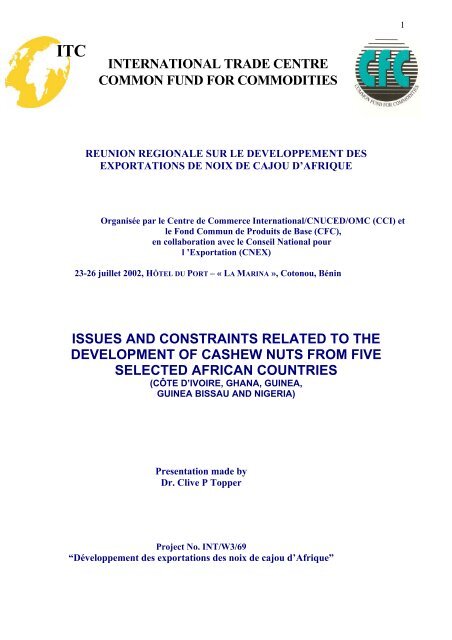
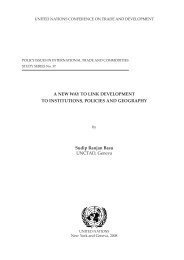


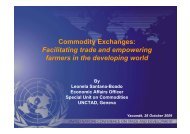
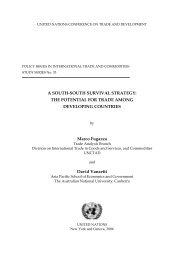
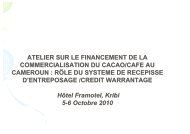
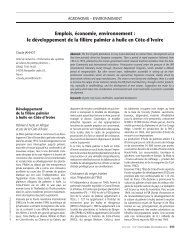
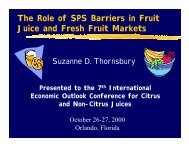

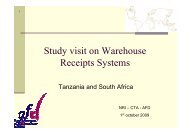
![Warehouse Receipt Systems: Legal Issues [PDF]](https://img.yumpu.com/43979338/1/190x134/warehouse-receipt-systems-legal-issues-pdf.jpg?quality=85)
